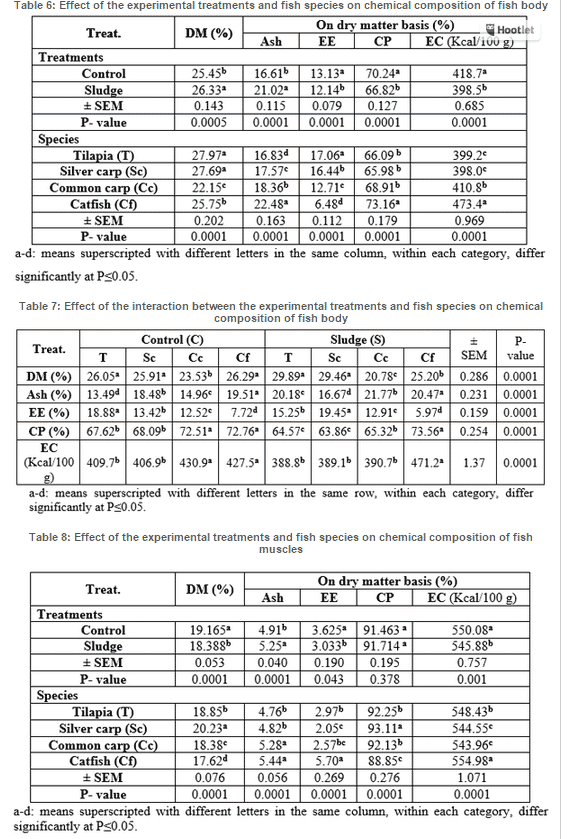Most of the Egyptian wild (marine, brackish and fresh) water bodies are contaminated with agricultural, industrial and urban drainage, which are responsible for their water and fish pollution with different heavy metals (Abdelhamid et al., 2006 and 2013a & b) at levels exceeding the Egyptians’ tolerance limits (ES, 1993 and Abdelhakeem et al., 2002). Heavy metals polluted water is causative for ca. thirty-two danger diseases (Abdelhamid, 2006). Fish may also respond to a stressor by altering their physiology to the point that natural resistance and immunity to disease is reduced and they become more susceptible to infectious diseases (Wedemeyer, 1997). So, many intoxications could be occurred in humans consume fish reared under polluted water conditions (Abdelhamid and El-Ayouty, 1991; Shata, 1996 and Abdelhamid et al., 1999) or fish fed contaminated diets (Abdelhamid, 1983 and Abdelhamid et al., 1996). This year (2014) will be a milestone year, where the per capita consumption of farmed fish will be greater than wild fish consumption (Koeleman, 2014).
In this respect, sewage sludge (night soil or urban waste) may be used in aquaculture. However, the use of untreated night soil as a fertilizer as a source of nutrients in fish farming presents a considerable health hazard in the form of pathogens and parasites. Moreover, fish ponds receiving nutrients derived from treated night soil were less contaminated than those of untreated night soil was applied, and the fish reared in them were of superior quality (Ling et al., 1993). The aim of the present study was to investigate to what extend could the sewage sludge affect the growth performance, feed utilization and chemical composition of some freshwater fishes in a polyculture system.
MATERIALS AND METHODS
The experimental management:
This study was conducted during the summer season 2013 in a private fish farm (of Dr. Salah Ibrahim) at Tolompat 7, Alriad, Kafr El-Sheikh governorate, Egypt, during the period from 21 / 7 / 2013 to 30/10/2013. Nile tilapia, silver carp and African catfish were purchased from a private fish farm, Kafr El-Sheikh governorate, Egypt. While, common carp were purchased from Integrated Fish Farm at Al-Manzala (General Authority for Fish Resources Development – Ministry of Agriculture), Al-Dakahlia governorate, Egypt. Fish were stocked into a net Hapa for two weeks, as an adaptation period, and fed a basal diet.
Fish were distributed into two experimental treatments (in two covered-net Hapas, to prevent jumping of silver carp); in the first treatment (the control group), fish were fed the basal diet, whereas in the second treatment, fish were fed a sludge. Each Hapa (8*3*1 m) was constructed and implanted in an earthen pond. Four fish species were distributed with an average initial body weight of Nile tilapia O. niloticus 178 ± 3.5 g, common carp Cyprinus carpio 232 ± 2.75 g, silver carp Hypophthalmichthys molitrix 344 ± 4.3 g and African catfish Clarias gariepinus 408 ± 3.2 g). Stocking density was 100 fish / Hapa at a rate of 1: 1: 1: 1 for Nile tilapia, common carp, silver carp and African catfish.
The basal diet was purchased from Almorshedy for Trading and Development, Meet Ghamr – Al-Dakahlia – Zagazig Road, Egypt. This commercial diet contained yellow corn, soybean meal (44% CP), wheat bran, fish meal (65% CP), corn gluten (60% CP), lime stone, common salt, dicalcium phosphate, and molasses and had not less than 25% crude protein, 3% crude lipids, 3935 Kcal gross energy/Kg diet, and not more than 5.30% crude fiber, according to the manufacture's formula. The dried treated sewage sludge was obtained from the duple stage treatment project (Sanitary Drainage Station, Kafr El-Sheikh at Al-Riad, Kafr El-Sheikh governorate, Egypt). The tested diet and sludge were offered once daily (10:00 am) at 5% of the fish biomass at each Hapa. The feed quantity was adjusted each 21 days according to the actual body weight changes. Some physical and chemical properties of water were measured, such as temperature, pH, alkalinity and dissolved oxygen in the water basin at weekly intervals.
Fish sampling and fish performance parameters:
At the end of the experiment, fish samples were collected and kept frozen until the proximate analysis of the whole fish body and the dorsal muscles. Growth performance parameters of the fish were calculated, such as average total weight gain (TWG, g), average daily gain (ADG, g/fish/day), relative growth rate (RGR, %), specific growth rate (SGR, %/day) and survival rate (SR, %). Feed conversion ratio (FCR), and protein efficiency ratio (PER) were calculated acording to Abdelhamid (2009).
Also, fish samples (five fish/species/Hapa) were collcted to measure the indivedual body weight, total length and stander length to calculate condition factor (Kt) based on total length and (Ks) based on stander length. Then, fish samples were killed to remove the head and viscera, fins and scales to calculate dressing percentage from the equation: [Eviscerated-entheaded fish weight, g/whole fish body weight, g.] and to remove the bones to calcluted filled percentage from the equation:[the weight of muscles, g (removed with an sharp knife from the vertebra of the dressed fish)/ total weight, g} x100 %] (Ali et al., 2013).
Chemical analysis of fish: Chemical (proximate) analysis of fish (for 5 fish / species / treatment at the end of the experiment), food, and sewage samples was carried out according to AOAC (1995) for dry matter, crude protein, ether extract, and ash (as well as crude fiber of food and sewage). The gross energy contents of the experimental diet and fish were calculated by using factors of 5.65, 9.45 and 4.2 Kcal/g of protein, lipid and carbohydrate, respectively (NRC, 1993). Statistical analysis: Using SAS (2001) and Duncan (1955), numerical data collected were statistically analyzed for analysis of variance and least significant difference at propability (P) level of ≤ 0.05.
RESULTS AND DISCUSSION
Water quality:
The obtained values of water quality parameters in the earthen pond were 25±3 ºC for water temperature, 8.80 pH, and 2.66 ppm for dissolved oxygen (DO). This alkalinity may be attributed to proliferation of phytoplankton for the presence of sewage sludge. Also, the low level of DO may be due to increased chemical (COD) and biological oxygen demands (BOD). In this context, Edwards et al. (1994) fond that buffalo manure was responsible for reducing penetration of light, which may have contributed to the low phytoplankton biomass and relatively low DO. Abdel-Halim et al. (1998) registered also low DO and high pH vale, being 3.01-3.37 ppm and 8.32-8.63, respectively. Also, Nagdi et al. (1998) measured pH value and DO concentration in chicken litter treated ponds as 8.2 and 1.11 ppm, respectively.
Hafez et al. (2002) referred to increased growth rate of Nile tilapia as a consequence of increasing of different varieties or species of phytoplankton and zooplankton and the water alkalinity with treating fish ponds with poultry litter than the control. An investigation was undertaken to study the importance of different physico-chemical parameters of water related to recycling of organic waste through aquaculture in a man-made lotic biological sewage treatment system. The levels of parameters such as water temperature, transparency, pH, dissolved oxygen, free carbon dioxide, total alkalinity, total hardness, calcium hardness, chloride ion, nitrite nitrogen, nitrate nitrogen, ammonium nitrogen, orthophosphate, biochemical oxygen demand, dissolved organic matter, and primary productivity did not indicate a pollution problem.
Although higher levels of carbon dioxide and lower levels of dissolved oxygen caused asphyxiation in early hours of some days, fish mortality was not observed probably due to flowing nature of water (Manna et al., 2003). Abdel-Tawab and Sweilum (2004) recorded higher pH value (8.6) with using organic fertilizer (manure). A consistent increase in ammonium concentration was measured downstream of fish farm, but not the sewage effluent input. The sewage effluent input was a point source of dissolved organic nitrogen (DON) with an increase of 15 μM. Nitrate was the major component of dissolved nitrogen in this aquifer-fed chalk-bed system, with up to 10% being DON and ammonium comprising<1% (Homewood et al., 2004). A study deals with the assessment of some physico-chemical and fisheries activities of a sewage fed Jannapura tank for its suitability of human consumption and fish culture have been carried out. Phosphate, nitrate, BOD and oxygen were used as indicators of possible nutrient enrichment in the tank.
This water body continuously receiving sewage from the surrounding residential areas. Nitrate, phosphate and BOD values were high depicting cultural eutrophication occurring from surface runoff of nitro-phosphate fertilizers from nearby lands into the tank and the present findings revealed that the water quality of the tank is productive and eutrophic. In addition, fish diversity, species cultured, fish marketing, advantage and disadvantages of sewage fed fisheries in the present water body are discussed (Kiran, 2014).
Commercial diet and sewage sludge:
Table 1 presents data of proximate analysis of the control (C) diet and sewage (S) sludge on dry matter basis. The S seemed to be CP-richer than C; yet, S contained very high percentage of ash and very low percentages of EE and total carbohydrate comparing with C.
However, different wastes are frequently used in fish feeding (Abdelhamid, 2014a) from plant, animal and/or variable sources such as dried blue green algae (Salama, 2003), sugar beet pulp (Magouz, 1996 and Khalafalla and Salem, 2006), corn gluten meal (El-Ebiary et al., 2001), tomato and potato by-products (Soltan, 2002), dried dropping dates (Srour et al., 2002 and Nour et al., 2004), fig jam by-product (El-Dakar et al., 2003), coffee pulp (Rojas and Verreth, 2003), sesame hulls by-product (Abd Elmonem et al., 2004), wastes of biscuits Manufacture Company (El-Saidy, 2004), biological treated legumes by-products (Khalafalla et al., 2012), medicinal plants (Ibrahim et al., 2012 and Abdelhamid and Soliman, 2013), palm pollen grains (Abou-Zied et al., 2013), duck weed and/or freshwater crayfish (Abdelhamid et al., 2012a&b), poultry by-product and feather meal (Gaber, 1996), poultry industry wastes (Srour, 2003 and Ayaad and Hassouna, 2005), fish by-product protein concentrate (Hanafy, 2008), silkworm pupae meal (Salem et al., 2008) and fermented fish silage (Abd El-Hakim et al., 2013).
Moreover, plant and animal wastes are used also as organic fertilizers for fish ponds including buffalo manure (Edwards et al., 1994); duck droppings (Abdel – Halim et al., 1998 and Abou Zied, 2007); duck and buffalo manures (Abdel-Hakim et al., 1999); poultry or cow manure (Abdel-All et al., 2001); poultry litter (Hafez et al., 2002); blue green algae and chicken manure (Bakeer et al., 2003); cow manure, chicken manure, sugarcane bagasse compost and rice straw compost (Hafez et al., 2003); poultry and cow manure (Abdel – Tawab and Sweilum, 2004); poultry manure (Hassan, 2004 and Hassanien et al., 2008); poultry manure (Abdel-All et al., 2001 and Hassan, 2004); cow manure (Hassan et al., 2005); poultry drops, silkworm wastes and fresh rumen contents (Agouz and Gomha, 2011) and green fertilizers and manures (Abdelhamid, 2014b). Table 1: Chemical composition of the tested commercial diet and sewage sludge (% on dry matter basis)

Sanitary drainage is the waste water from the human activities (municipal, domestic and industrial waste water). It consists of more than 99.99% water and less than 0.1% solids. In Egypt, man can produce daily in Egypt ca. 54 g organic substances, from which 42 g suspended and 12 g soluble. Generally, the pollution of water resources with human-house wastes is responsible for the outspreading of colonic diseases.
So, the aim of treating the waste water is to prevent outspreading of diseases and ground water pollution besides the protection of fish wealth (CTC, 2010/2011). Sewage sludge when well treated could be used for reclamation of sandy and light soils for its inclusion of fertilizer elements which are good for preserving the water by soils. It had been used as organic fertilizer for different trees (wooden forestry and fruits), forages and crops (cotton, soya bean, pees, wheat, line, field beans, maize), although it raised the plant contents of some heavy metals as Ca, Co and Pb, since sewage is containing high levels of heavy metals according to the industrial drainage which differ from time to another and from location to location (CTC, 2010/2011).
Meanwhile, sewage sludge had been used in Viet Nam and India before a century in feed fish culture system. Though there are fears about the safety of the fish grown in sewage fed systems, it is the general belief that the fish grown in sewage tastes better. This has been partly attributed to the good nutrition obtained from the rich plankton growth in ponds. There is opportunity to develop systems suitable to each of the urban centers to produce fish using sewage and avoid environmental damage, being caused by the discharge of untreated sewage (Dalsgaard, 1996 and Nandeesha, 2002).
However, using sewage sludge in fish farming is one of methods of overcoming the shortage in fish foods which are facing some competition between human beings and animal species because of the outspreading of aquaculture which reached nowadays more than 70% of the Egyptian total fish yield (Osman, 2012). Fish culture is a must under the present conditions of over fishing and pollution of the wild water bodies that led to disappearance of some fish species from the wild water bodies and decreased the natural catch (Shalaby, 2000).
Growth performance:
The obtained results confirmed (regardless of fish species) that feeding fish the sewage sludge led to significantly (P≤0.01) lower values of growth performance parameters comparing with those fed the control (commercial) diet. However, regardless of dietary treatments, silver carp (Sc) performed better (P≤0.01) than tilapia (T), followed by common carp (Cc) then catfish (Cf), respectively (Table 2). The interaction analysis revealed also that Sc reflected the best (P≤0.01) values of all tested growth parameters (Table 3); among all fish species tested (the worst fish species was Cf), particularly that fed sewage sludge than that fed control diet. All fish species performed better on sewage sludge than the control diet, except Cc that performed better on commercial diet than on sewage sludge.
This may be due to different feeding habits of different fish species as well as to various factors included in sewage sludge. However, silver carp reflected better growth performance although the catfish had heavier initial bodyweight. Also, tilapia was more tolerated for sludge feeding, which may be for its feeding habits. In this respect, Natarajan and Varghese (1980) tested the effects of poultry manure, digested sewage sludge cake and cow-dung on plankton production and fish growth. Both plankton production and fish growth (Catla catla and Cyprinus carpio var. Communis) were found to be the highest in the poultry manure treatment, followed by the sludge cake and cow-dung treatments. Compared with the cow-dung treatment, total fish production was 50.6% more in the poultry manure and 19.0% more in the sludge-cake treatment.
Khourabia et al. (1991) also concluded the successful rearing of Nile tilapia with common carp in polyculture system at a ratio of 5:1 which seems to be more desirable than tilapia alone in a monoculture. Moreover, El-Serafy et al. (1993) found that some fish species such as silver carp and common carp reached near the maximum carrying capacity in shorter time than that for the other fish species (bighead carp, grass carp, mullet and Nile tilapia) in the polyculture system.

Generally, Abdel-Halim et al. (1998) registered maximum net return of polyculture (tilapia + common carp + silver carp) with chemical fertilizers plus duck droppings than with control. Also, Nagdi et al. (1998) found that tilapia gave high production and was more economic in chicken manure pond than the control one. Moreover, Sweilum (1998) reported more growth performance for Nile tilapia in a polyculture system with silver carp than with common carp. Abdel-Hakim et al. (1999) registered lower growth and return for Nile tilapia, blue tilapia and common carp with duck manure or buffalo manure than the control, without variations among fish species. Yet, Abdel-All et al. (2001) found that poultry manure resulted in the highest total yield for Nile tilapia. Additionally, Abdel-Gawad et al. (2003) reported that polyculture (Nile tilapia + silver carp + mullet) performed (final body weight and total production) well with artificial feeding than without artificial feeding (poultry manure+ inorganic fertilizer only).
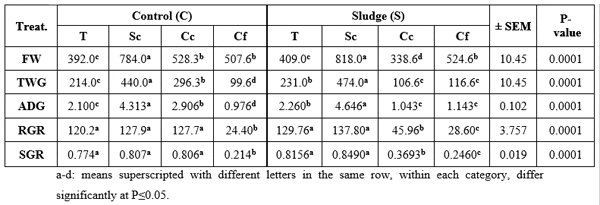
Moreover, Hafez et al. (2003) recommended the use of cow or chicken manures in fertilizing fish ponds produced superior performance for Nile tilapia than common carp. However, there is an estrogenic response in the reproductive cycle of common carp and crucian carp, in relation to a sewage treatment. This may suggest that at moderately polluted sites, biological variations of carp and genetic particularities are prevalent (Sole et al., 2003 and Diniza et al., 2005a). In addition, vitellogenin induction in males mirror carp was used as a biomarker of exposure to xenoestrogens (Diniza et al., 2005b).
Hassan et al. (2005) obtained the highest net production and return for common carp in ponds fertilized with poultry manure than for those from ponds treated with cow manure. In addition, Abdelhamid et al. (2007) found that water parameters (temperature, pH, DO, salinity and phytoplankton) did not differ in integrated system (fish-cum-duck); yet, zooplankton number increased as well as growth performance (final bodyweight, body weight gain, specific growth rate, total fish production, and super and 1st class fish production) of Nile tilapia improved. Also, sewage incorporation yielded similar gross fish production as recorded from fertilizer based system, whereas net water productivity using sewage as nutrient source was found to be higher than that of a fertilizer based system (Dasgupta et al., 2008). Chicken manure produced better growth performance than inorganic fertilizer (Hassanien et al., 2008).Additionally, Agouz and Gomha (2011) reported significantly (P≤0.05) higher final weight of Nile tilapia with poultry drops than with silkworm waste, fresh rumen content and control (feed pellets). Yet, silkworm treatment reflected the best survival rate.
Feed utilization:
Feed utilization parameters of fish fed control diet were better than for those fed sewage sludge. The Sc and T showed the best values, whereas Cf had the worst (Table 4). The interaction between fish species and dietary treatments (Table 5) showed significant (P≤0.01) effects on feed utilization parameters, where Sc fed sewage sludge consumed the highest food quantity, but T fed sewage sludge had lowest food consumption; therefore, T fed sewage sludge had the best FCR and PER, but control Cf had the worst FCR and PER. Moreover, the Nile tilapia, common carp and African catfish significantly improved FCR and PER of sewage sludge compared with the control diet. This may be due to increased CP % in sewage sludge (30.21%) compared with the control diet (25.75%). Also the African catfish gave the worst values of FCR and PER as compared to the other farmed species, which may be reflected in decreased growth performance parameters. This could be due to the different feeding habits of African catfish, which classified as carnivores or predators and that need a high dietary protein. Machiels and Henken (1985) reported 40% crude protein as an optimal requirements for C. gariepinus (40 – 120 g). Pantazis (1999) concluded that Clarias gariepinus performed best when fed diets containing 46% crude protein.
Also, El-Gendy (2009) found that the best dietary crude protein and fat levels were 35.9 and 11.7%, respectively. The control diet and the sewage sludge contained 25 and 30 % CP, respectively, which were not enough for the optimal growth of African catfish. On the other hand, Khourabia et al. (1991) calculated FCR for Nile tilapia in a polyculture system as 1.58-2.82. Magouz (1996) calculated FCR for Nile tilapia fed at 40% sugar beet pulp as 5.67. Also, Sweilum (2001) reported better growth rate, yield and food conversion of Nile tilapia using polyculture combination with catfish than with Sarotherodon galilaeus. Moreover, Kheir et al. (2002) obtained similar growth performance among fish or prawn reared alone or in polyculture.
This result may indicate that growth of both species was not affected by the presence of the other species. The FCR was better in the polyculture than in the monoculture indicating that the polycultured species consumed less feed and utilize the fed more efficiently than the monocultured ones. Srour et al. (2002) obtained FCR of 5.47, 7.11 and 6.95 by feeding dried dropping date for Nile tilapia at 50, 75 and 100% of the diet. Yet, Kheir and Saad (2004) gave better growth, production and FCR for Nile tilapia with catfish (which was used as police fish to control recruitment of Nile tilapia) in polyculture.
Additionally, Abdelhamid (2011) revealed that monoculture of all males mono-sex Nile tilapia was more better than polyculture (Nile tilapia plus silver carp) concerning their superiority in final bodyweight, bodyweight gain, specific growth rate, feed conversion ratio, feed cost/kg bodyweight gain, economic efficiency, and return. Yet, Brummett and Alon (1994) reported that tilapia growth and feed conversion were adversely affected by the presence of crayfish. Abdel-Tawab and Sweilum (2004) recorded slightly lower feed conversion with organic fertilizer (manure) than with artificial feeding of Nile tilapia. Yet, Abou Zied (2007) mentioned that Nile tilapia reared in the integrated ponds with Peking ducks exhibited better body weight, fish yield, food conversion, and return than those of the non-integrated ponds.
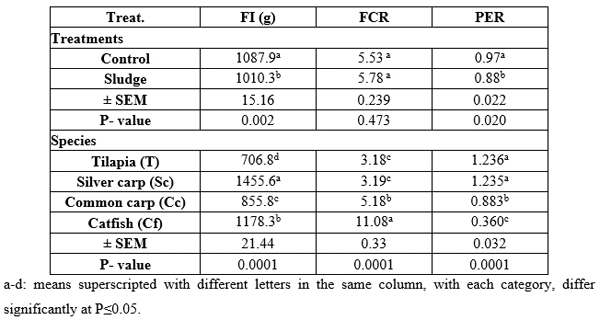

Chemical composition:
Chemical composition of the whole fish body (regardless of fish species) was significantly better (lower ash and higher CP percentages) with feeding control diet than with feeding sewage sludge (Table 6). The Cf contained the highest ash and CP percentages and the highest EC but the lowest EE percent among all tested fish species. However, the interaction effect was significant , since the highest DM % was found with T fed sewage sludge, the lowest ash % was determined in control fed T, the lowest EE % and the highest CP % and EC were estimated and calculated with CF fed sewage sludge (Table 7).
Concerning proximate analysis of fish muscles, regardless of fish species, there were slight (although significant) differences between both dietary treatments (Table 8). Regardless of dietary treatments, Sc contained highest (P≤0.01) DM and CP percentages and lower ash EE and EC among all tested fish species. The interaction (fish species X dietary treatments) effects were significant, since the best DM was found with feeding Sc the sewage sludge, ash, EE and CP with control Sc (Table 9). In this respect, Yip and Wong (1977) raised carp in a sewage effluent and different concentrations of digested sludge. The highest growth rate of carp occurred in the 0.2% sludge, followed by the sewage effluent and 0, 0.4, 0.6 and 0.8% media.
Similar results were obtained from measurements of the dry weights and protein contents of the carp at the end of the experiment. Additionally, Saini and Sharma (1999) tried sewage sludge - a common urban refuse as supplementary feed for the fish (Cyprinus carpio L) at 0, 50, 75 and 100%. The fish was raised on the experimental diet for 60 days. Common carp fed 100% sewage sludge failed to indicate appreciable growth. However, partial replacement (50%) was favorable and resulted in high growth. Fish reared at 50% sewage sludge supplemented diet also attained high protein level as compared to control and other treatments. Yet, Abdel-Tawab and Sweilum (2004) recorded lowest CP and highest DM and ash in Nile tilapia whole body with using manure as fertilizer than with artificial feeding. However, Hassan (2004) registered gradual increases in final weights, net yield, profitable regime and DM and CP contents of the whole tilapia body with increasing poultry manure levels as pond fertilizer.
In relation to the chemical composition of the whole fish body, fishes fed sludge resulted in increasing of EE in common carp, and ash in Nile tilapia and silver carp, also to decrease the content of CP in the same species (Table 7). Regarding the chemical composition in muscles, feeding fishes (Nile tilapia, common carp and silver carp) the sewage sludge increased the EE % and decreasing the CP % (Table 9) compared with the control diet, which reflected in reduction in the quality of meat produced from these fishes.
Condition factor, dressing and boneless (fillet):
Condition factor, dressing and fillet percentages were not affected significantly (P≥0.05) by dietary treatments, regardless of fish species (Table 10); while all parameters were affected by fish species at P≤0.01 (regardless of dietary treatments), being the highest for T and the lowest Kt, Ks and dressing were calculated for Cf and the lowest fillet was calculated for Cc. The interaction effect between fish species and dietary treatments was not significant (P≥0.05) for Kt and Ks values, where the highest values were in T and the lowest ones in Cf compared with other species fed control diet or sewage sludge.
Also, T showed significantly the highest dressing percentage whether fed control diet or sewage sludge as compared to the other species (Table 11). In this respect, Abdel-All et al. (2001) found that Nile tilapia reared in earthen ponds fertilized with poultry manure (400 kg/Feddan) resulted in the highest significant (P≤0.05) dressing (66.9%), flesh (54.4%) and return than those reared in ponds fertilized with 200 kg/Feddan poultry manure with or without artificial food (1.5%) or cow manure or inorganic fertilizer. The controversial effects among literature and the present results may be attributed to differences in fish rearing systems (monoculture, polyculture, semi-intensive, intensive, cages, earthen ponds, source and quality of rearing water, stocking density, feeding or not, and what about feed composition?), the fish (species, age, health status, and the ratio between species) and the organic fertilizer (source, composition, and rate).
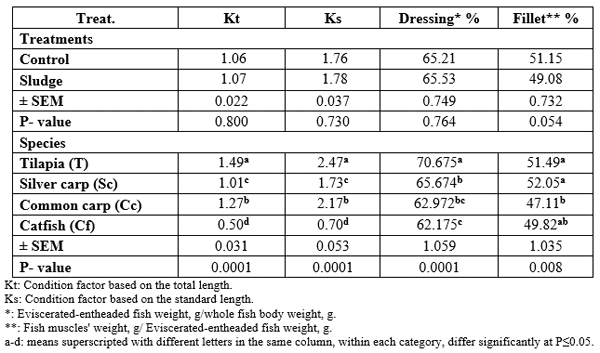
CONCLUSIONS
From the above mentioned results in the present study, feeding fish species (Nile tilapia, common carp and African catfish) with sewage sludge improved growth performance and feed utilization, but it led to decreased content of CP and increasing content of EE and ash in the whole fish body and muscles, which reflected in reduction of meat quality for these species. So, it is not recommended to use sewage sludge in fish feeding, although its use in cultured fish feeding is wide spreading in Kafr El-Sheikh governorate.
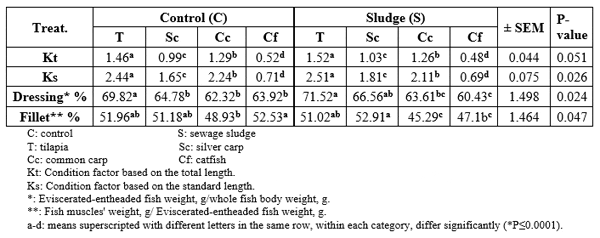
December 2014

